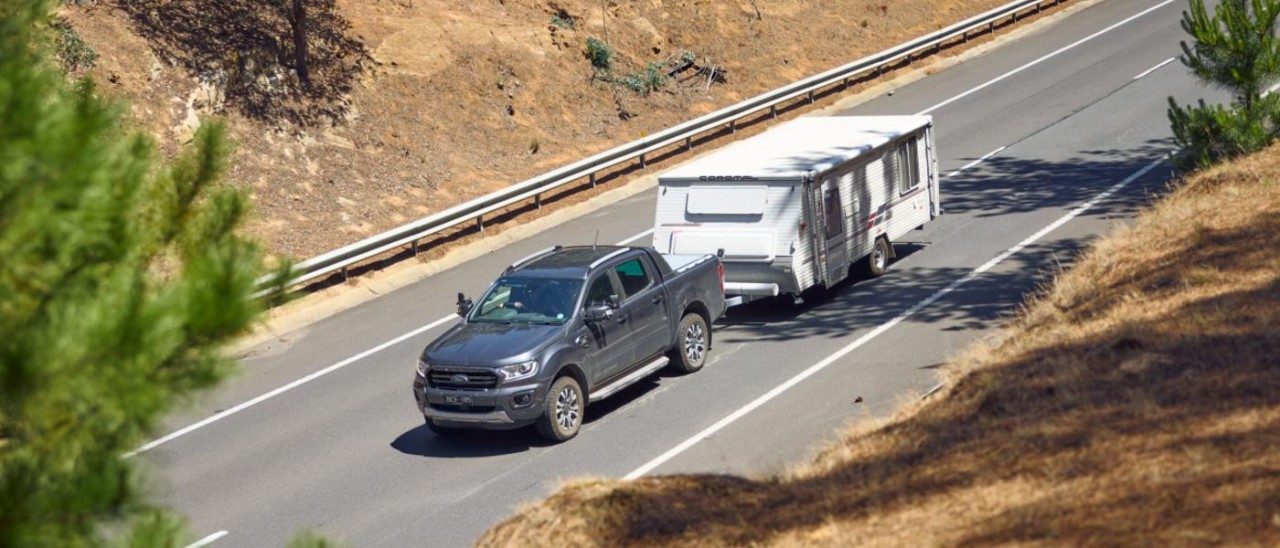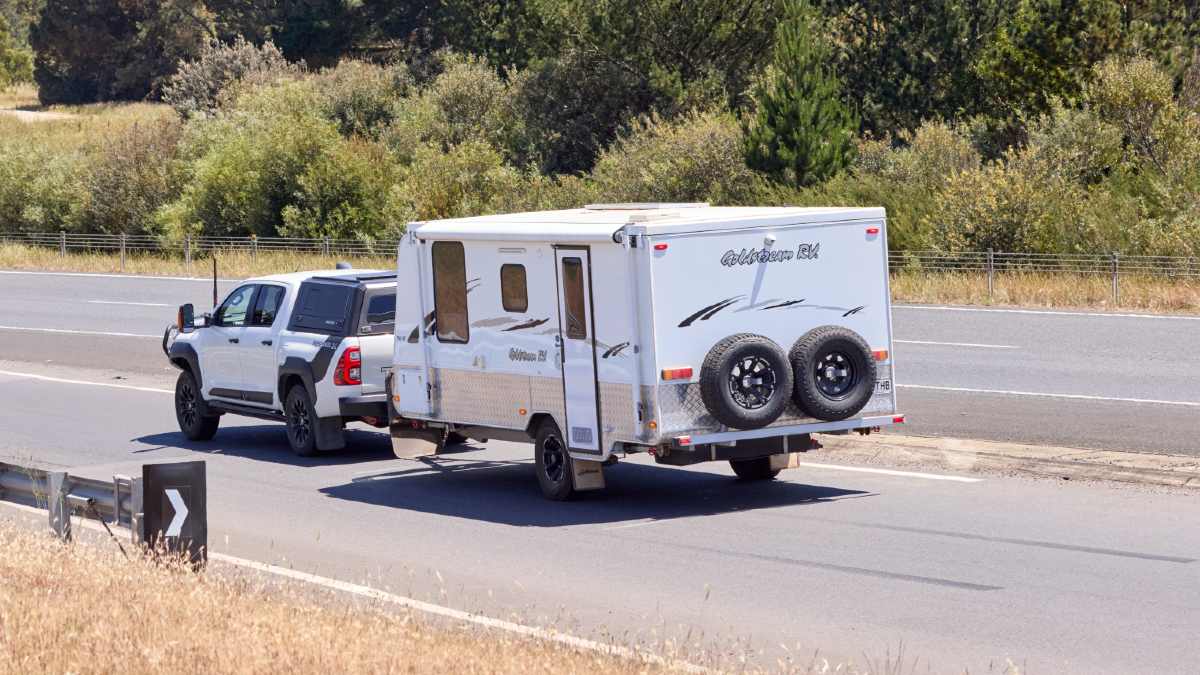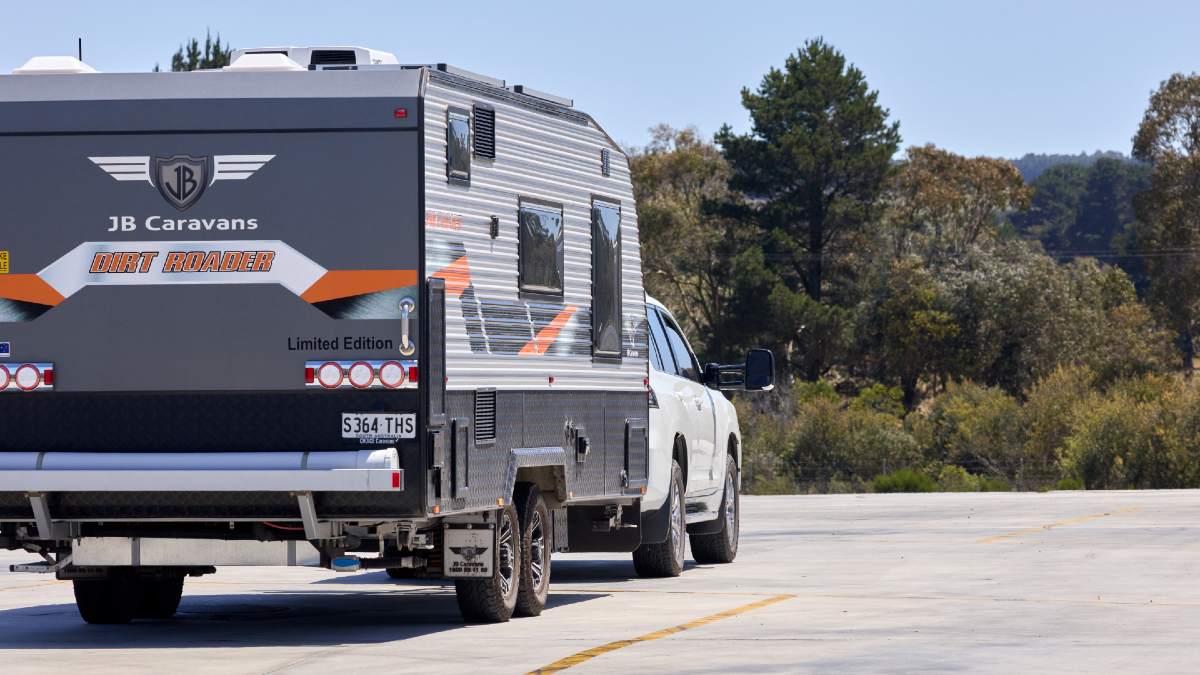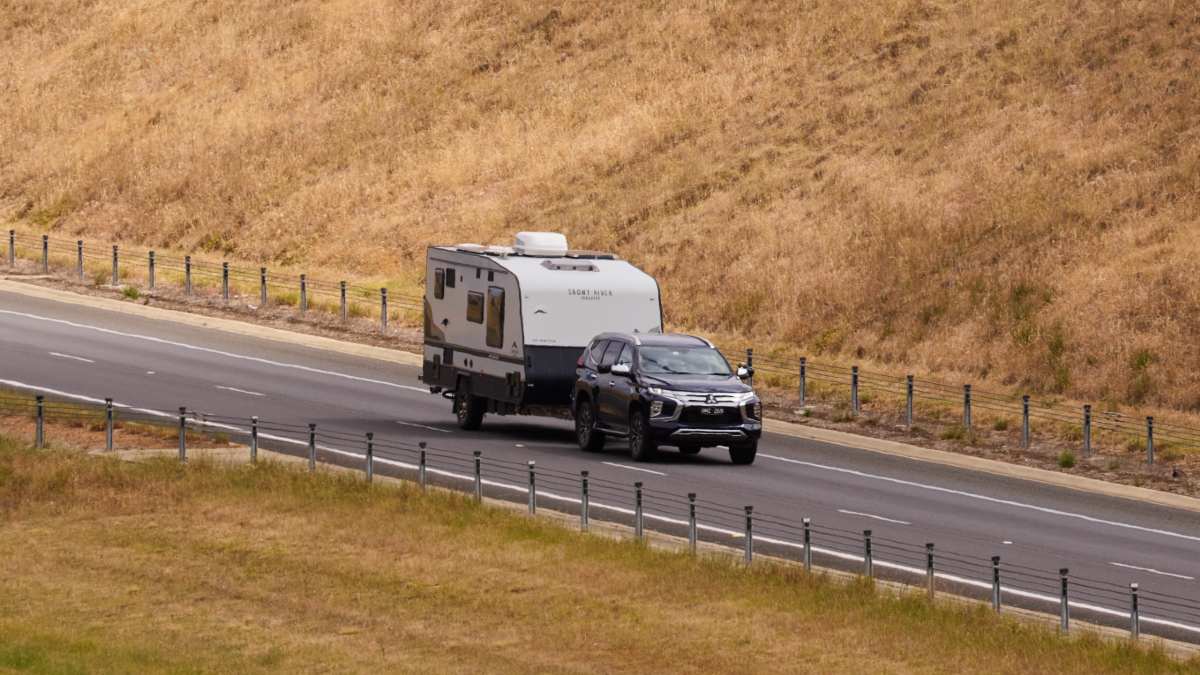Have you ever been tempted to give the mobile-home holiday a go? Here’s everything you need to know about buying a new or used caravan.
How to tow a caravan: a beginner's guide

If you've never towed before, the process can feel daunting. This guide is designed to walk you through the essentials - from hitching up safely, to understanding towing weights, road rules, and best driving practices.
For many Australians, the idea of hitching up a caravan and setting off on the open road is the ultimate adventure. Caravanning offers the freedom to travel at your own pace, the comfort of taking your home with you, and the opportunity to explore many parts of Australia, whether it's the ultimate Murray River road trip or a Melbourne to Darwin road trip.
If you’re towing a caravan for the first time, the process can feel a bit overwhelming. But with the right preparation and advice, you’ll soon feel confident on the road.
Here is everything beginners need to know about towing a caravan, from the basics of weight and safety checks, to driving techniques, reversing tips and important legal considerations.
Interested in caravanning?
How to safely tow caravans
Choose the right tow vehicle
Not every car is designed to tow a full-size caravan, so the first step is making sure your vehicle is up to the task.
RACV Motoring Editor, Andrea Matthews says it's important to consider what you'll be towing, so you can choose the best vehicle for your needs. "Australians are well known around the motoring world for our love of towing, so when vehicles arrive here, the manufacturer often has towing towards the top of the list of attributes. Many vehicles are developed with towing capability as a number one consideration, so you'll find some excellent options to meet your needs." said Andrea.
"For the job of towing a modern caravan, you'll likely be looking at dual-cab utes and large SUVs as they have high towing capacities and torque-y powertrains to get the job done. You can get away with a medium SUV for towing a lightweight camper trailer, but for the comfortable home-away-from-home vans which have now become the gold standard for road tripping, you'll need something beefier."
Its no coincidence that many of the top ten best-selling vehicles in Australia are also compentent towing vehicles. The Ford Ranger, Ford Everest, Toyota Landcruiser Prado, and Isuzu D-Max are all among the top sellers and all offer braked towing capacity of 3500kg, what's considered the benchmark for tow vehicles.
For more heft, the Ford Ranger Super Duty which is set to arrive in Australia next year will have 4500kg braked towing capacity, while bigger American-style trucks like the Toyota Tundra, Ford F-150 and Chevrolet Silverado 1500HD also boast similar capacity.
If you're looking an using an electric vehicle or plug-in hybrid vehicle, be aware that the towing capacity will be lower, and any towing will significantly impact driving range. Some EVs may not be engineered for towing so check that out before you commit to buy.
The BYD Shark 6 is currently the country's most popular plug-in hybrid ute but only offers a braked towing capacity of 2500kg so is best-suited to smaller caravans.
More: Research and compare towing vehicles
When choosing a vehicle, consider:
- Braked towing capacity - most caravans over 750kg require electric brakes. Make sure your vehicle's braked towing capacity matches or exceeds the caravan's aggregate trailer mass (ATM).
- Engine torque - torque does all the work when you're towing, which is why so many people turn to diesel engines for towing caravans and trailers. Modern turbo diesels can produce plenty of grunt without needing to rev too hard, making them ideal for hauling heavy loads.
- Transmission - automatic transmissions are calibrated for towing. Shifts can be managed through modern towing technology, such as in the Kia Tasman. When fitting a towing kit, ask your fitting supplier to ensure the correct harness and software has been fitted, allowing for correct transmission calibration to ensure the transmission operates with the correct gearing when towing.
- Cooling system - towing puts extra stress on the engine and transmission. Vehicles with upgraded cooling systems will perform better in hot conditions.
If you're buying a new caravan and already own a car, choose a van that suits your vehicle's capabilities. Don't be tempted to buy a van at the top of your vehicle's capacity, as you'll need to factor in the weight of all your gear and passengers.

Towing is a complex issue for caravan, boat and horse-float owners. Image: Matt Harvey
Understand caravan weights
Before you even think about hitching up, it's essential to understand caravan weights and how they affect safety and legality. These terms often cause confusion, but knowing them is critical.
- Maximum tow capacity - the weight that a car can safely and legally tow.
- Tare weight - the weight of the caravan when it leaves the factory, including all fittings, but excluding passengers, water, luggage and accessories you add later.
- ATM (aggregate trailer mass) - the maximum weight the caravan can legally weigh when fully loaded. This includes everything inside and on the caravan, including water and gas.
- GTM (gross trailer mass) - the maximum weight supported by the caravan's wheels when hitched to a tow vehicle.
- Tow ball weight (down weight, tow ball download) - the downward force exerted on the tow vehicle's tow ball by the caravan's coupling when the car is parked on a level surface. Typically, this is around 10 per cent of the caravan's total weight.
- GVM (gross vehicle mass) - the maximum weight of your tow vehicle when fully loaded, including people, luggage and fuel. When calculating the GVM, you must subtract the tow ball weight, since it's exerting pressure (weight) onto the vehicle.
- GCM (gross combination mass) - the maximum allowable combined weight of the tow vehicle and caravan, along with everything in them.
Just because an SUV or ute says it can tow 3.5 tonnes doesn't mean it can in reality – at least if you want to take passengers and gear with you. Once you take into account all the weight limits, some tow vehicles will only let you carry a few hundred kilograms.
Exceeding these limits can make your rig unstable, void insurance and even result in fines. Always check your tow vehicle's manual and the caravan's compliance plate to ensure you're within the legal weight limits.
Plan ahead and weigh your gear weeks before your first trip. You will be surprised to see how quickly the weights mount up and may need to rationalise your packing. Ask an experienced caravanner how they tackle the weights challenge - you're likely to hear some clever solutions to help you travel light!
How to hitch up a caravan safely
Hitching up is one of the most important parts of the towing process. It's worth taking your time to do it properly.
- Line up your vehicle - slowly reverse your tow vehicle until the tow ball is directly under the caravan's coupling.
- Lower the coupling - use the jockey wheel to lower the caravan onto the tow ball. Lock the coupling in place.
- Attach safety chains - cross the chains under the coupling and connect them to the tow bar. This helps catch the drawbar if the hitch fails.
- Connect electrics - plug in the trailer wiring to connect brake lights, indicators and caravan brakes.
- Raise jockey wheel - retract the jockey wheel and secure it in its holder.
- Check brake controller - if using electric brakes, make sure the brake controller in the vehicle is correctly adjusted.
Always perform a walk-around safety check before driving off, making sure all lights are working correctly. Look for loose items, open hatches or unsecured gas bottles.

Torque counts when towing large caravans. Image: Matt Harvey
Safe driving techniques for towing
Towing a caravan changes the way your vehicle behaves. It accelerates slower, brakes later and is more affected by wind and road conditions. With practice, you'll develop a feel for it.
Here are some key tips for beginners:
- Take it slow - drive at a comfortable, legal speed. Remember that towing speed limits in some states are lower than normal.
- Leave more space - allow extra distance between you and the vehicle in front, as stopping distances increase dramatically with a caravan.
- Smooth inputs - accelerate, brake and steer smoothly to reduce sway and improve stability.
- Watch your mirrors - extended towing mirrors are often required to give you a clear view down the sides of the caravan.
- Handle corners carefully - caravans cut in more than cars. Take wider turns to avoid clipping kerbs.
- Watch for crosswinds - gusty winds, especially when passing trucks, can cause sway. Ease off the accelerator and keep a firm grip on the wheel.
Braking when towing a caravan or trailer
Braking is one of the biggest differences when towing. Caravans over 750kg ATM must have their own braking system to reduce the strain being put on the tow vehicle's brakes.
Up to 2,000kg you can have mechanical brakes, which activate a piston or cable when the trailer pushes against the car. Over 2,000kg, you need electronic trailer brakes, which 'talk' to a brake controller in the car. This in-car brake controller lets you adjust the brake bias (how aggressively the trailer brakes compared with the car) and independently apply the trailer brakes to control sway.
Caravan sway can be caused by wind, passing vehicles, uneven loads or poor weight distribution. To minimise sway, load heavy items low over the caravan's axle and avoid overloading the rear of the caravan. Reduce speed if sway begins and do not brake suddenly.
Some modern caravans and vehicles even have electronic stability control systems that can automatically apply brakes to counter sway.
You can also use your water bottles as ballast to even out the weights. Talk to an experienced hand or your caravan retailer for more tips.
How to reverse a caravan
Reversing a caravan is the part most beginners find intimidating. It takes practice and patience.
Here are some simple tips:
- Practice in an empty car park - before hitting the road, spend time in a safe, open space.
- Use a spotter or two-way radio - if you're travelling with someone, get them to guide you. Agree on clear hand signals.
- Go slowly - small adjustments make it easier to control the caravan.
- Don't oversteer - gentle steering inputs are more effective.
- Straighten up gradually - once the caravan starts heading where you want it, straighten the steering wheel to follow.
Remember: it's perfectly fine to stop, pull forward and try again.

If you are towing over two tonnes, electronic brakes are a must. Image: Matt Harvey
Fuel consumption when towing
One of the first things new caravan owners notice is how much more fuel their vehicle uses once there's a caravan hitched to the back. Towing places extra strain on the engine, increases aerodynamic drag and adds significant weight, all of which affect fuel economy.
Several factors influence how much fuel you'll use when towing:
- Caravan size and shape - a tall, boxy caravan creates more wind resistance than a smaller, more aerodynamic model.
- Vehicle engine type - diesel engines typically perform better under load and are more fuel-efficient for long-distance towing than petrol engines.
- Driving speed - fuel consumption increases dramatically at higher speeds. Dropping from 110km/h to 90km/h can save several litres of fuel per 100 kilometres.
- Weight - every kilogram counts. Keeping loads balanced and avoiding unnecessary gear helps reduce fuel burn.
- Terrain - steep climbs and soft, unsealed roads make engines work harder and use more fuel.
- Wind and weather - headwinds can noticeably increase drag, while tailwinds may improve efficiency.
The information provided is general advice only. Before making any decisions please consider your own circumstances and the Product Disclosure Statement and Target Market Determinations. For copies, visit racv.com.au. As distributor, RACV Insurance Services Pty Ltd AFS Licence No. 230039 receives commission for each policy sold or renewed. Product(s) issued by Insurance Manufacturers of Australia Pty Ltd ABN 93 004 208 084 AFS Licence No. 227678.


